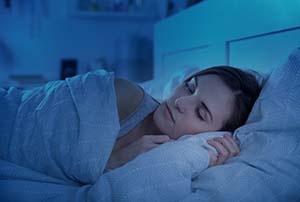
Lack of sleep is a big problem in the United States. Many people do not get enough good sleep. Also, they do not get sufficient natural light for optimal health. Furthermore, people today surround themselves with artificial blue light from overhead lighting and digital screens.
As you probably know, an artificial blue light overload can cause headaches, eye fatigue, and difficulty finding sleep and staying asleep. Do you expose your eyes to blue light from digital devices, especially before you go to bed? If so, your body thinks it should stay awake even if you are tired.
Why Sleep Is Important
Studies show that sleep is a critical factor in various health issues. Researchers link chronic insomnia with the following problems:
Weakened immunity
Difficulty concentrating
Weight gain and obesity
High blood pressure
Premature aging
Heart disease
Poor academic and work performance
Mental health disorders like anxiety, depression, and bipolar disorder
Furthermore, there is a direct link between poor sleep and a significant increase in workplace injuries and traffic accidents. Despite these problems, people are getting less quality sleep than ever before.
How Does Light Affect Sleep?
You have a 24-hour internal clock that determines your wake-sleep cycle. It is responsible for various biological responses, including when you start feeling sleepy and how many hours of sleep you need. Your internal clock tends to change over your lifetime. For example, you fell asleep later and slept longer as a teen. By contrast, the internal clock shifts to earlier mornings and fewer hours of sleep.
The pineal gland in the center of your brain, also referred to as the third eye, controls your sleep-wake cycle. One of its primary roles is to secrete melatonin, the sleep-causing hormone. Light dictates this function.
During the day, the photoreceptors in the retina absorb sunlight and then send messages to the pineal gland to suppress melatonin secretion. The gland secretes more melatonin when the sun goes down as your body prepares for sleep. At least, that is how it should work. Unfortunately, it is a tad more complicated today.
Blue Light and Sleep
Studies show that exposure to blue light can delay melatonin secretion and duration. Using low-wattage table lamps or dimmer switches, you can mitigate the effects of bright lighting before bedtime. Using light in the red spectrum can help as well.
The biggest problem is the digital devices people position mere inches from their eyes. The blue light from these devices confuses the pineal gland and disrupts the sleep-wake cycle. Digital screens emit blue light that mimics daylight, thereby suppressing melatonin secretion.
Red Light and Sleep
Red light wavelengths help stimulate melatonin production, helping you sleep. That does not mean using red-tinted light bulbs. Some blue light can still penetrate such bulbs. It means using light bulbs that emit red light wavelengths, such as red LEDs that emit a single specific wavelength of light.
Red Light Therapy for Sleep
Red light therapy affects the body’s capabilities for performance and healing. It involves concentrating near-infrared and red light on the skin to trigger the cell mitochondria to produce energy more efficiently.
Increased energy production allows body organs and tissues to function more efficiently in various ways, including ways that can improve sleep. Furthermore, red light therapy helps boost melatonin secretion and reduces sleep inertia.
Conclusion
If you suffer from sleep issues, you are not alone. According to the American Sleep Association, about 30 percent of Americans experience acute insomnia, while 10 percent experience chronic insomnia. Many insomnia treatments are mostly band-aid solutions. Some even border on dangerous and unhealthy.
For more on red light therapy, visit South Bay Wellness Center & Chiropractic at our San Jose, California office. Call (408) 642-6060 to schedule an appointment today.



